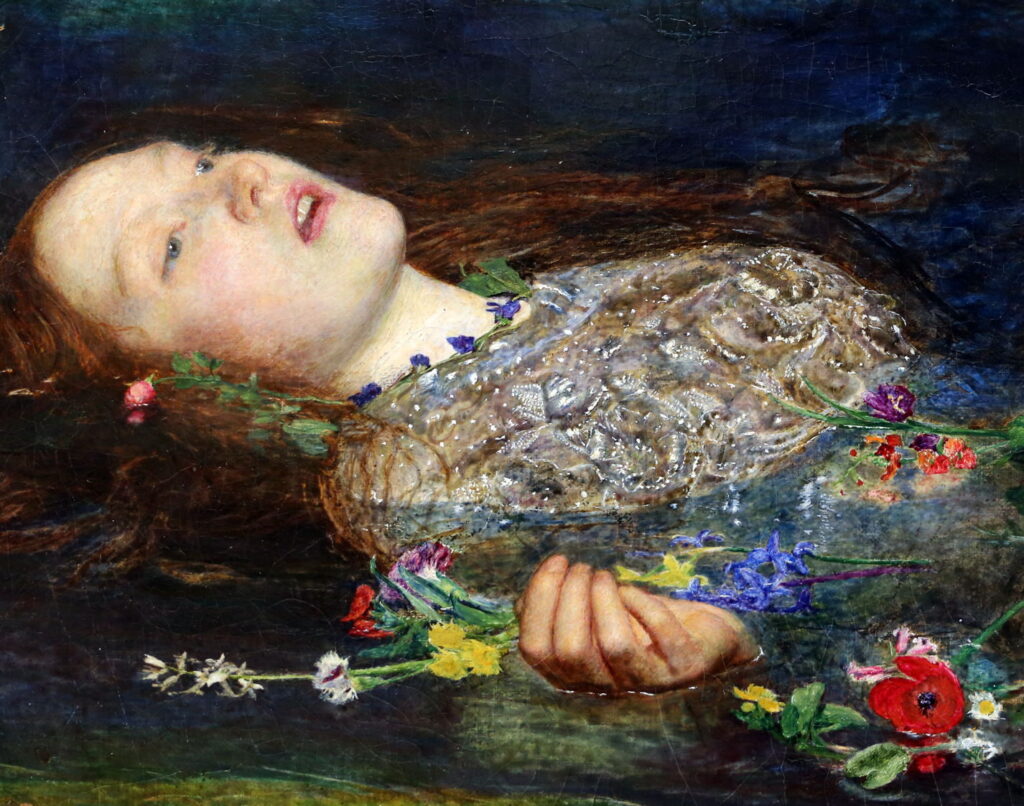Reading visual art: 82 Language of flowers B

After the Renaissance, the language of flowers continued in European paintings but didn’t really blossom again until the Pre-Raphaelites and those associated with the movement in Britain during the middle and late nineteenth century. With a wider choice of literary references and changing traditions some of their paintings became even harder to read.
Talbot Hughes (1869-1942), Echo (1900), oil on canvas, 66 × 119 cm, Private collection. Wikimedia Commons.
Talbot Hughes’ Echo from 1900 refers to the classical myth of Echo and Narcissus, showing the nymph splayed across most of its foreground, surrounded by narcissus flowers, and the ghostly image of a man appearing in the waterfall at the top left, with its poignant reflection. Echo is in a rocky gorge, where we would expect to hear echoes, and holding her right hand cupped against her ear, and even wears narcissus flowers in her hair.
Evelyn De Morgan (1855–1919), Night and Sleep (1878), oil on canvas, 42 × 62 cm, The De Morgan Centre, Guildford, Surrey, England. Wikimedia Commons.
Evelyn De Morgan’s Night and Sleep, from 1878 shows two figures flying through the air, from right to left. The further figure is a young woman (probably) wearing long red robes, her eyes closed, clutching a large brown cloak with her right hand. That cloak floats above the couple. Her left arm is intertwined with the right arm of what is probably a young man, who wears shorter brown robes. He also has his eyes closed. He clutches a large bunch of poppies to his chest with his left arm, while his right scatters them, so that they fall to the ground below.
Although it has been stated that this painting was inspired by the flight of Zephyr and Chloris in Botticelli’s Birth of Venus (c 1486), I think that may have been largely compositional. With her thorough classical education, De Morgan is more likely to be referring to one of Virgil’s most famous lines, from his Aeneid Book 4, line 486:
hinc mihi Massylae gentis monstrata sacerdos,
Hesperidum templi custos, epulasque draconi
quae dabat et sacros servabat in arbore ramos,
spargens umida mella soporiferumque papaver.
haec se carminibus promittit solvere mentes
quas velit, ast aliis duras immittere curas…
From thence is come
a witch, a priestess, a Numidian crone,
who guards the shrine of the Hesperides
and feeds the dragon; she protects the fruit
of that enchanting tree, and scatters there
her slumb’rous poppies mixed with honey-dew.
Her spells and magic promise to set free
what hearts she will, or visit cruel woes
on men afar.
(From Perseus at Tufts University)
Spargens umida mella soporiferumque papaver is conventionally translated as “scattering moist honey and sleep-inducing poppy”, and describes well the effects of the opiate drugs derived from opium poppies, which were popular and readily obtainable at the time.
John William Waterhouse (1849–1917), The Annunciation (1914), oil on canvas, 99 × 135 cm, Private collection. Wikimedia Commons.
Just before the First World War broke out, John William Waterhouse painted his one and only religious work, The Annunciation (1914). It remains deeply traditional, with Gabriel bearing white lilies for Mary, who is kneeling and has dropped her spinning.
Dante Gabriel Rossetti (1828–1882), The Beloved (‘The Bride’) (1865–6), oil on canvas, 82.5 x 76.2 cm, The Tate Gallery (Purchased with assistance from Sir Arthur Du Cros Bt and Sir Otto Beit KCMG through the Art Fund 1916), London. © The Tate Gallery and Photographic Rights © Tate (2016), CC-BY-NC-ND 3.0 (Unported), http://www.tate.org.uk/art/artworks/rossetti-the-beloved-the-bride-n03053
Dante Gabriel Rossetti’s The Beloved (‘The Bride’) had been commissioned in 1863, but wasn’t completed until early 1866. Originally intended to show Dante’s Beatrice, a favourite theme of Rossetti and others at the time, it came to be based on the Old Testament’s greatest love poetry, the Song of Solomon. Rossetti inscribed its frame with the quotations:
My beloved is mine and I am his. (Song of Solomon 2:16.)
Let him kiss me with the kisses of his mouth: for thy love is better than wine. (Song of Solomon 1:2.)
She shall be brought unto the King in raiment of needlework: the virgins her companions that follow her shall be brought unto thee. (Psalm 45 v 14.)
The bride in the centre, modelled on Marie Ford, wears an intricate leather headdress from Peru and a Japanese kimono, although the latter is wrapped around her in an idiosyncratic manner rather than being worn as the Japanese garment would have been. Her attendants crowd around her, making the composition very shallow, and adding exotic touches in their skin colours and appearance. Its symbols are few and simple: roses for love being offered up by the boy in the front, and red lilies for passion and physical love.
Sophie Gengembre Anderson (1823–1903), Elaine (The Lily Maid of Astolat) (1870), oil on canvas, 158.4 x 240.7 cm, Walker Art Gallery, Liverpool, England. Wikimedia Commons.
Sophie Gengembre Anderson’s Elaine or The Lily Maid of Astolat from 1870 refers to Tennyson’s retelling of Malory’s legends of King Arthur, published in 1859. Elaine, who had fallen in love with Sir Lancelot, nursed him back to health following his injuries in a tournament. When she learned that her love for the knight would remain unrequited, she died of a broken heart. She had made clear that on her death, she wished her body to be taken by boat to Camelot, bearing a last letter, as shown here: Elaine’s body is ghostly white, and holds lilies as a sign of her virginity, together with her parting letter to the knight.
William Holman Hunt (1827–1910), Isabella and the Pot of Basil (1867), oil on canvas, 187 x 116 cm, Laing Art Gallery, Newcastle upon Tyne, England. Wikimedia Commons.
William Holman Hunt’s Isabella and the Pot of Basil from 1867 refers to the tragic tale of Lisabette in Boccaccio’s Decameron. Its intricate details include several references to elements of the story, such as the relief of a skull on the side of the pot, a red rose on a tray by Lisabetta’s left foot, and a silver watering can at the bottom right.
Few of these wonderful paintings compare in the quantity and range of species to those of Botticelli or Poussin, with the exception of John Everett Millais’ Ophelia.
John Everett Millais (1829–1896), Ophelia (1851-2), oil on canvas, 76.2 x 111.8 cm, Tate Britain, London. Wikimedia Commons.
Millais painted its background en plein air near Ewell, Surrey, England, during 1851. The figure of Ophelia was painted in over the following winter, using as the model Lizzie Siddal in a bathtub full of water.
He used extensive symbolism in the flowers shown: roses for love, and possibly alluding to her brother calling her the ‘rose of May’; willow, nettle and daisy for forsaken love, suffering, and innocence, respectively; pansies for love in vain; violets (in her necklace chain) for faithfulness, chastity, or young death; poppies for death; forget-me-nots for remembrance. Each was painted in the studio from life, and superimposed on the background to form a composite image which never existed in reality.
Dante Gabriel Rossetti (1828–1882), The Blue Bower (1865), oil on canvas, 84 × 70.9 cm, Barber Institute of Fine Arts, Birmingham, England. Wikimedia Commons.
Several of Dante Gabriel Rossetti’s portraits speak in the language of flowers. The Blue Bower from 1865 shows one of his favourite models Fanny Cornforth with her eyes directed at the viewer, her hair loose and her clothing open and inviting. Her hands are idly caressing the strings of an instrument which is exotic and oriental: Rossetti probably didn’t know, but it’s a Korean koto. Cornforth is surrounded by passion flowers, the decorative blue background alluding to their heavy scent, and the sense of smell. The delicate light blue cornflowers in the foreground are probably just a visual pun on her surname.
Occasionally, paintings don’t just require identification of the species of flower, but detailed knowledge of their characteristics.
George Frederic Watts (1817–1904), Choosing, A Portrait of Ellen Terry (1864), oil on canvas, dimensions not known, The National Portrait Gallery, London. Wikimedia Commons.
In February 1864, George Frederic Watts married the actress Ellen Terry just short of her seventeenth birthday, when she was nearly thirty years younger than him. He soon painted her in Choosing, A Portrait of Ellen Terry (1864). She is making the choice between large, showy but unscented camellia flowers, and humbler but fragrant violets, symbolising the choice between the material and spiritual, an unusual variation on the traditional theme of love sacred and profane. Sadly, for Watts his new wife’s choice became clear when she ran off with another man within a year of their marriage. I’m not sure how you’d say that with flowers.



